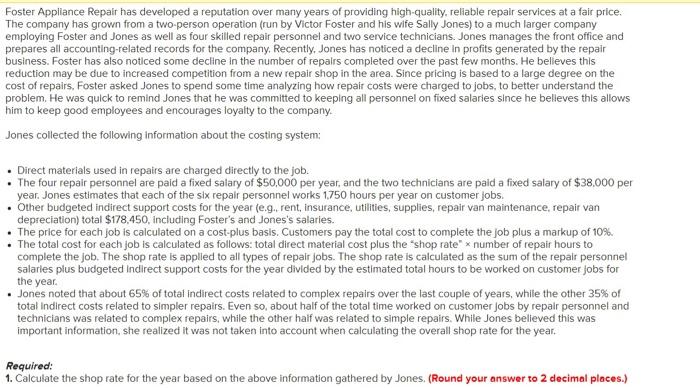

Foster Appliance Repair has developed a reputation over many years of providing high-quality, reliable repair services at a fair price. The company has grown from a two-person operation (run by Victor Foster and his wife Sally Jones) to a much larger company employing Foster and Jones as well as four skilled repair personnel and two service technicians. Jones manages the front office and prepares all accounting-related records for the company. Recently. Jones has noticed a decline in profits generated by the repair business. Foster has also noticed some decline in the number of repalrs completed over the past few months. He believes this reduction may be due to increased competition from a new repair shop in the area. Since pricing is based to a large degree on the cost of repairs. Foster asked Jones to spend some time analyzing how repair costs were charged to jobs, to better understand the problem. He was quick to remind Jones that he was committed to keeping all personnel on fixed salaries since he belleves this allows him to keep good employees and encourages loyalty to the company. Jones collected the following information about the costing system: - Direct materials used in repairs are charged directly to the job. - The four repair personnel are paid a fixed salary of $50,000 per year, and the two technicians are paid a fixed salary of $38,000 per year. Jones estimates that each of the six repalr personnel works 1,750 hours per year on customer jobs. - Other budgeted indirect support costs for the year (e.g. rent, insurance, utilities, supplies, repair van maintenance, repair van depreciation) total $178,450, including Foster's and Jones's salaries. - The price for each job is calculated on a cost-plus basis. Customers pay the total cost to complete the job plus a markup of 10%. - The total cost for each job is calculated as follows: total direct material cost plus the "shop rate" number of repair hours to complete the job. The shop rate is applled to all types of repair jobs. The shop rate is calculated as the sum of the repalr personnel salarles plus budgeted indirect support costs for the year divided by the estimated total hours to be worked on customer jobs for the year. - Jones noted that about 65% of total indirect costs related to complex repairs over the last couple of years, while the other 35% of total Indirect costs related to simpler repairs. Even so, about half of the total time worked on customer jobs by repalr personnel and technicians was related to complex repairs, while the other half was related to simple repairs. While Jones believed this was important information, she realized it was not taken into account when calculating the overall shop rate for the year. Required: 1. Calculate the shop rate for the year based on the above information gathered by Jones. (Round your answer to 2 decimal places.) 2. Use the information gathered by Jones about the proportion of complex and simple repairs each year to calculate different shop rates that could be applied to complex and simple repair work. (Round your onswers to 2 decimal places.)








